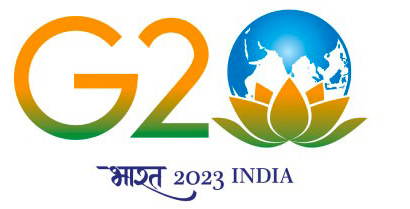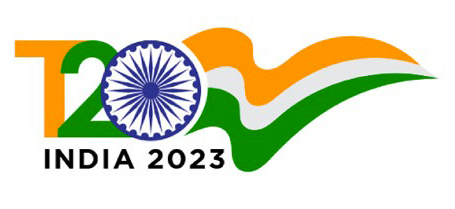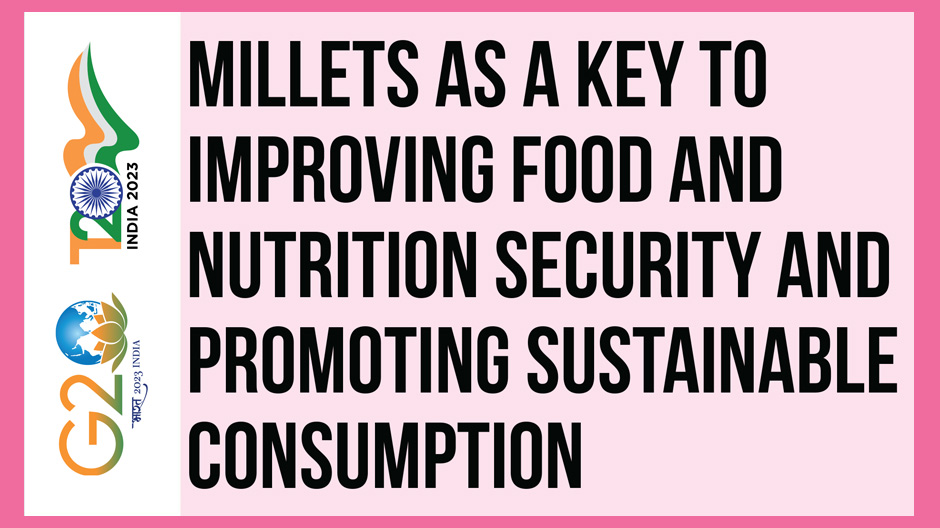Task Force 3: LiFE, Resilience, and Values for Wellbeing
Millets have high nutritional value, are resilient to a changing climate, require fewer resources compared to other popular grains, and are often regarded as ‘nutri-cereals’ or ‘superfoods’. Despite their benefits and their historically bigger share in diets across geographies, the cultivation and consumption of millets is sharply declining. Millets could be key to ensuring food and nutrition security, resource sustainability, and economic empowerment. Thus, it is critical to create policies towards reversing the global trends of decreasing consumption and production of millets, and enhance consumer awareness of their nutritional and health benefits. With the United Nations declaring 2023 as the International Year of Millets, this ‘superfood’ can be brought to the fore as an important grain for the dietary habits of humans.
1. The Challenge
Millets, often referred to as ‘superfoods’, can boost sustainable agriculture and help achieve a healthier world (see Annexure). It is an ancient grain that has been grown for about 5,000 years, particularly in countries like India, China, and Nigeria. Despite the wide range of benefits that millets provide, they have largely been missing from the global food security agenda. Before the Green Revolution, millets made up around 40 percent of all cultivated grains, contributing more than wheat and rice.[1] The world population is projected to touch 8.5 billion in 2030, and to increase to 9.7 billion by 2050 and to 10.4 billion by 2100; such growth will create a demand for increased food production.[2] In addition to food demand, changing climate and rainfall patterns are putting massive stress on the environmental balance required for agriculture. This is evident in events like more intense and frequent droughts and floods and erratic rainfall. The delicate balance between agriculture and climate can further lead to deficits in global food stocks. This has repercussions in developing countries, where nutritional security is a massive challenge for the growing population.
To promote sustainable agriculture, there is a need to diversify cropping patterns and increase the area under millet production. Millets, being a short-duration and climate-resilient crop that can be grown even in harsh, hot (up to 64°C), and dry environments and respond well to available nutrients,[3] can be preferred for crop rotation and mixed cropping.
Water stress
Climate change, population growth, and water pollution are among the factors that contribute to water scarcity and stress. In many regions, water resources are over-exploited or mismanaged, leading to the depletion of groundwater and surface water sources. Regions that may be particularly affected by water scarcity include parts of Africa, West Asia, and Central Asia. However, water scarcity is also becoming a problem in parts of North America, Europe, and Asia. Only 3 percent of the world’s water is freshwater, two-thirds of which is in frozen glaciers or is otherwise unavailable for use.[4] According to the United Nations, more than 2 billion people worldwide do not have access to safe drinking water, and many more lack access to water for agricultural and industrial use. Around 3.6 billion people do not have access to safely managed sanitation,[5] while 4 billion people experience severe water scarcity for at least one month each year.[6]
Efforts to deal with water scarcity and stress include investments in water infrastructure, better management of water resources, and promotion of water conservation and efficiency. Since water is an essential input for agriculture and allied activities, water scarcity can further lead to food shortages and nutritional crises; approximately 55 million individuals worldwide experience the effects of drought annually, making it the most critical threat to agriculture and livestock in all regions.[7],[8]
Figure 1: Populations Living Under Water Stress and Shortages Globally (2001–2010)[9]
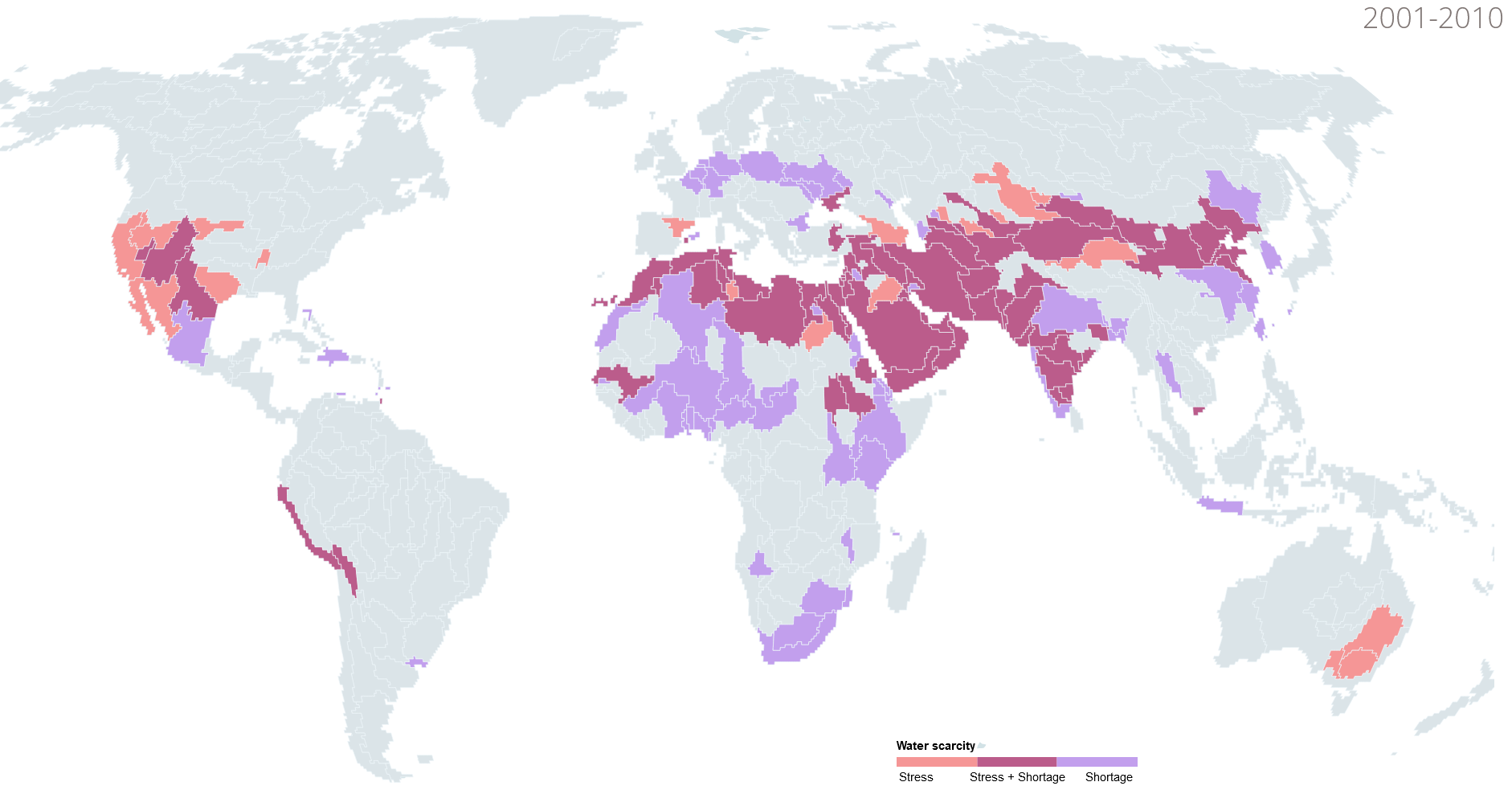
Compared with commonly known cereals, millets can grow under drought and non-irrigated conditions as they have a low water footprint. For example, while sugarcane requires 2,100 mm of water during the growing period and rice requires 1,250 mm, millets require less than 500 mm. Finger millet and pearl millet can be grown with 350 mm of water, while sorghum requires 400 mm.[10]
Crop diversification is important in the context of persistent poor nutrition and food insecurity despite the growth in global food production, supply, and distribution. Millets provide essential vitamins and micronutrients that can bolster nutrition for populations in dryland areas. They are rich sources of nutrients, such as carbohydrates, protein, fibre, and good-quality fats, and contain significantly higher amounts of minerals, such as calcium, potassium, magnesium, iron, manganese, zinc, and B-complex vitamins. Millets are an excellent source of slow digestive starch and fibre.[11] The presence of 1.5–5 percent fat, 65 percent carbohydrates, and 6–12.5 percent protein makes them energy-dense and an excellent choice for fortification against malnutrition.[12] Millets also have other dietary qualities that can help stave off anaemia, celiac disease, and diabetes.[13]
Apart from the direct benefits to nutrition and food security, as well as their low water footprint, millets also have certain indirect benefits. They help small farmers in efficient crop rotation as they require only 60–90 days to mature while other grains take 100–140 days.[14] Millets efficiently use available nutrients and respond well to improved agro-land conditions, thereby reducing the dependence on synthetic fertilisers and pesticides and increasing yield by up to three times.[15] The high carbon content of the crop residues also helps maintain and increase soil carbon and provide forage for livestock. This can secure farmer incomes, and the value-added products provide livelihood opportunities across the millet value chain. It can also lead to a reduction in rural–urban migration.
A high nutritional value, coupled with the hardiness of small millets, makes them desirable food security crops and a good source of fodder and feed in mixed crop and livestock systems.
Factors governing millet production
The demand-side factors governing millet production include:
- Increasing urbanisation and per capita incomes, which are changing consumer tastes and preferences.
- Poor social status and lack of traditional knowledge in preparing millets.
- Lower shelf-life of millet grains.
- Larger share of rice and wheat in the public distribution system (PDS) compared to millets.
The factors on the supply side are:
- The lack of industrial demand for value-added millet products, which discourages farmers from cultivating millets.
- Low profitability and low remuneration.
- The favoured production of rice and wheat during the Green Revolution.
- Lack of access to quality seeds.
- Inadequate infrastructure, such as processing technologies and milling equipment.
Factors influencing millet production and consumption may vary with cultural, social, and environmental conditions. While these factors are the root causes of the declining global millet production and consumption, they also provide solutions that can reverse declining global trends.
Millet production and consumption patterns
According to the Food and Agriculture Organization (FAO), the acreage of millet under cultivation in 2020 was 33 million hectares globally. This includes only a few countries that grow millets around the world. In 2021, the millet acreage in India was globally the highest (9.76 million hectares), followed by Niger (6.14 million hectares) and Sudan (2.8 million hectares).[16] The FAO estimates that global millet production was 28.33 million tonnes in 2019, which increased to 30.08 million tonnes in 2021. India is the largest producer, with a 43-percent global market share in 2021; the produce consists mainly of sorghum (jowar), pearl millet (bajra), finger millet (ragi), and other minor millets. As shown in Figure 2, while the area cultivated for millet has been on the decline globally since 1971, production quantity has remained near-equal to that in 1961, ranging from 25 million to 30 million tonnes. There has been a decline in the production trends since 1981, from 43.4 million to 37.4 million hectares, which nearly steadied after 1991, despite a decrease in harvested area, which further declined to 30.93 million hectares.
Figure 2: Global Millet Production Trends[17]
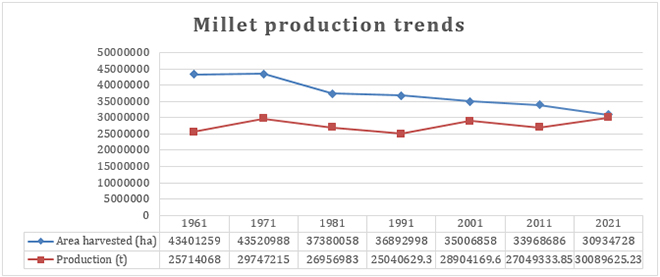
Source: FAOSTAT
2. The G20’s Role
Millet production in the G20 countries
Millet production varies widely among G20 countries, depending on factors such as climate, soil quality, and agricultural practices. The top five G20 countries by millet production in 2020 were India (13.21 million tonnes), China (2.70 million tonnes), Russia (0.37 million tonnes), the United States (0.35 million tonnes), and Australia (0.04 million tonnes).[18],[19] Other G20 countries that produce millets include Mexico, Argentina, Brazil, South Africa, Turkey, and Russia. However, their productions are much lower than the top five countries.
India is a key producer with more than 13 million tonnes annually—or around 80 percent of Asia’s and 20 percent of global production.[20] The Indian government aims to provide farmers with more sustainable and profitable livelihoods by promoting the cultivation and consumption of millets.
According to the FAO, the area of millet cultivation in India in 2020 was 9.01 million hectares and its production was 12.4 million tonnes.[21] India is the top producer globally of barnyard (99.9 percent), finger (53.3 percent), kodo (100 percent), little millet (100 percent), and pearl millet (44.5 percent),[22] producing about 12.46 million tonnes from an area of 9.01 million hectares.
Figure 3: Millet Production (%) in Key Countries[23]
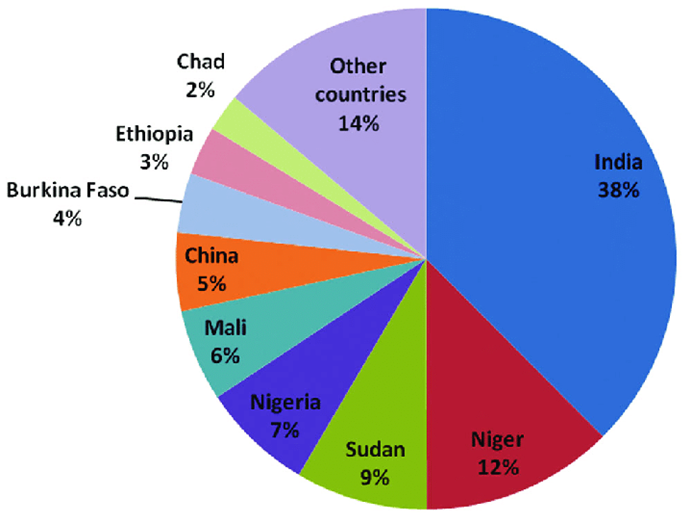
Millet consumption among the G20 countries
Of the top ten nations importing millets, seven belong to the G20, while four of the top five importers are G20 members.[24] According to the FAO, the top five G20 countries by millet imports in 2021 were Indonesia (77,921 tonnes), Belgium (31,815.9 tonnes), Germany (27,401.29 tonnes), Turkey (25,953.31 tonnes), and Canada (21,474.80 tonnes).
Millet consumption varies widely around the world, with some regions regarding it as staple while others consume it in smaller quantities, if at all. Millets are commonly consumed in parts of Africa and Asia, where it has been a dietary staple for thousands of years and are an important source of nutrition for people who may not have access to other expensive grains.
In more recent years, there has been growing interest in millets among consumers in developed countries, particularly as a gluten-free alternative to wheat and other grains. These millet products are being marketed as ‘health foods’ to increase the utilisation of small millets in popular foods. Small millet-based value-added products include traditional recipes, bakery products, pasta products, flaked and popped products, and instant-food mixes.
Besides its use as a food crop, millets are used for animal feed, biofuel, and in industrial applications.
Nutritional security and food security in the G20 and the world
Nutritional security and food security are interconnected concepts that are vital for the well-being of individuals, communities, and nations. The G20 countries and the European Union constitute about 85 percent of the world’s GDP, 75 percent of global trade, and two-thirds of the world’s population.[25] Thus, these countries play a significant role in ensuring nutritional and food security worldwide.
According to the FAO, as of 2021, the number of undernourished people worldwide had increased to 768 million due to the COVID-19 pandemic.[26] This highlights the criticality of nutrition and food security, especially in the G20 countries. In 2019, the G20 adopted the G20 Principles for the Agro-Food Value Chain to promote sustainable agriculture, food security, and nutrition. Among the G20 countries, the United States, Japan, and Canada are some of the countries that have high food security. In contrast, countries like India and Indonesia continue to face significant challenges.
To be sure, there have been recent improvements in food security globally. However, climate change, conflicts, and economic and political instability are creating significant impacts, especially in developing countries. Governments, international organisations, and the private sector must work together to promote sustainable agriculture, reduce food waste and loss, and improve access to healthy and nutritious food, particularly for the most vulnerable populations. The G20 Food Security and Nutrition Framework highlights the positive links between economic growth, job creation, food security, and nutrition. The EU has pledged 210 million euro in food assistance for the most vulnerable sections of the global population.[27]
3. Recommendations to the G20
The G20 countries need to improve the production and consumption of millets in order to lead the world towards sustainable food practices. Different regions can use a combination of these recommendations depending on their requirements.
Popularising millets and spreading awareness
The popularisation of millets may be achieved through various steps, such as the following:
- Educating farmers on the benefits of millet cultivation, including its high nutritional value and resilience to drought, and training them on best practices for millet farming, including planting, irrigation, and pest control.
- Incorporating millets in mid-day meals. The central government of India has asked state governments and union territories to add millets, including bajra, ragi, and jowar, to their mid-day meal schemes.
- Increasing the share of millets in PDS and nutritional programmes. For example, Odisha has planned to introduce millets in PDS, the mid-day meal scheme, and integrated child development services.
Increasing production and productivity
- Devising policies focusing on yield growth and area expansion.
- Incentivising farmers to grow millets and practise mixed cropping, besides providing financial support for processing, storage, and marketing.
- Providing farmers with financial support, high-quality millet seeds, and equipment such as threshers and harvesters to help them increase millet produce.
- Providing insurance coverage for alternate crops in crop diversification, as price risk and production risk are two major factors that influence the crop selection of farmers.
Infrastructure for millet processing
- Agro-industries should be provided technological support as well as support in setting up dedicated agro-processing institutes to enable more trained personnel in agro-industries.
- The removal of stones from harvested millets poses a significant problem, and governments should support the setting up of rural, community-driven processing facilities.
- The current de-husking machinery is available in small capacities—up to 2 tonnes per hour. This must be scaled up for bulk processing by food manufacturers.
- Secondary processing and product development involves the conversion of primary processed raw material into different ready-to-eat (RTE) and ready-to-cook (RTC) millet products. Various research and development (R&D) institutes, such as the Indian Institute of Millets Research under the aegis of the Indian Council of Agricultural Research (ICAR–IIMR), have been diversifying value-addition technologies such as puffing and baking. However, these R&D efforts must include private players for novel technologies. Startups that have obtained technology licences from ICAR-IIMR and other institutes have been marketing millet products with improved shelf lives.
- The shelf life of any raw millet flour is about 1–2 months, and 5–7 days for pearl millets, since they are prone to oxidative rancidity due to a high free-fat and sugar content. The shelf life of millets can be increased to 6–12 months if they are made into different value-added products and through the use of technologies like parboiling, irradiation, and germination.
Value chain addition
It is important for policy attention to be directed towards improving value-chain efficiencies. Post-production value addition with credible market linkages will not only benefit farmers but also increase the nutritional security of consumers. This value addition will result in RTC and RTE products similar to those of major cereals. The following steps may be undertaken to this end:
- Conducting stakeholder consultation meetings with private players in agro-industries and taking necessary policy decisions to encourage the setting up of more agro-processing industries.
- Developing research and technology for byproduct utilisation, without which the profitability of units will be affected; for example, soya bean has around 32 byproducts.
- Encouraging startups.
- Considering tribal youth for employment generation.
- Promoting various components of the value chain of millet processing through self-help groups and civil society organisations (CSOs) at the village and block levels, which can also lead to employment generation.
Transport and procurement
As millets are mainly grown in rural areas, transport and procurement facilities must be improved to encourage the use, cultivation, and sale of millets. Government programmes and initiatives to develop infrastructure, such as the PM Gram Sadak Yojana of India, should be considered for the transport and procurement of products.
Sale and export
Adding commercial value to millets will help promote them in the physical as well as e-market. This will increase farmers’ incomes as well as boost production. A policy on millet promotion should encompass the entire millet value chain to create domestic markets that would eventually trigger the international market. There is an urgent requirement for the containerisation of trade and the exploration of opportunities for dry ports.
Research and development
R&D must take place in millet farming, including the development of new millet varieties that are more resilient to drought and pests. Research is also required in various stages of the value chain to increase millet production and consumption.
Attribution: Akanksha Chand and Gaurav Thapak, “Millets as a Key to Improving Food and Nutrition Security and Promoting Sustainable Consumption,” T20 Policy Brief, July 2023.
Annexure
Comparative Analysis of Millet and Other Grains
Table 1: Nutrient Composition of Millets and Other Cereals[28]
|
Source |
Name of Food |
Protein (g) | Fat (g) | Ash (g) | Crude Fibre (g) | Carbohydrates (g) | Energy (kcal) | Calcium (mg) | Iron (mg) | Thiamine (mg) | Riboflavin (mg) | Niacin (mg) |
| RDA / AI | 12-15 g
18-20 g |
0.5 Child
0.6 Mother |
mentioned below | mentioned below | 0.2 – 1.5 | 0.3 -1.6 | 2-12 (0-9 yrs) & 16 -18 P mcg/day | |||||
| IFCT | Rice, Brown | 9.16 | 1.24 | 1.04 | 4.43 | 74.8 | 353.7 | 10.93 | 1.02 | 0.27 | 0.06 | 3.4 |
| IFCT | Wheat, Whole | 10.59 | 1.47 | 1.42 | 11.23 | 64.72 | 321.9 | 39.36 | 3.97 | 0.46 | 0.15 | 2.68 |
| IFCT | wheat, Flour | 10.57 | 1.53 | 1.28 | 11.36 | 64.17 | 320.3 | 30.94 | 4.1 | 0.42 | 0.15 | 2.37 |
| IFCT | Maize, Dry | 8.8 | 3.77 | 1.17 | 12.24 | 64.77 | 334.1 | 8.91 | 2.49 | 0.33 | 0.09 | 2.69 |
| IFCT | Sorghum (Jowar) | 9.97 | 1.73 | 1.39 | 10.22 | 67.68 | 334.1 | 27.6 | 3.95 | 0.35 | 0.14 | 2.1 |
| IFCT | Pearl millet (Bajra) | 10.96 | 5.43 | 1.37 | 11.49 | 61.78 | 348.0 | 27.35 | 6.42 | 0.25 | 0.2 | 0.86 |
| IFCT | Little millet (Samai) | 10.13 | 3.89 | 1.34 | 7.72 | 65.55 | 346.3 | 16.06 | 1.26 | 0.26 | 0.05 | 1.29 |
| *NRC, US | *Kodo millet | 9.8 | 3.6 | 3.3 | 5.2 | 66.6 | 353 | 35 | 1.7 | 0.15 | 0.09 | 2.0 |
Table 2: Mineral Composition of Millets and Other Cereals[29]
| Source | Name of Food | Phosphorous (mg) | Magnesium (mg) | Calcium (mg) | Iron (mg) | Zinc (mg) | Copper (mg) | Manganese (mg) | Molybdenum (mg) | Chromium (mg) |
| RDA / AI | 275 -460 / 500 / 700 mg/day | 26 -260 mg/day | 400-600 / 1300/ L1000 & 1300 P | 6.2 – 4.2, to 21.8
10 L |
4.1 – 4.8, Adol 7.2
10 P3 |
900 mcg/day | 2.34 | 45 mcg | 35mcg | |
| IFCT | Rice, Brown | 267 | 93.91 | 10.93 | 1.02 | 1.68 | 0.37 | 1.7 | 0.053 | 0.005 |
| IFCT | Wheat, Whole | 315 | 125 | 39.36 | 3.97 | 2.85 | 0.49 | 3.19 | 0.07 | 0.006 |
| IFCT | wheat, Flour | 315 | 125 | 30.94 | 4.1 | 2.85 | 0.48 | 2.98 | 0.02 | 0.006 |
| IFCT | Maize, Dry | 279 | 145 | 8.91 | 2.49 | 2.27 | 0.45 | 0.71 | 0.03 | 0.01 |
| IFCT | Sorghum (Jowar) | 274 | 133 | 27.6 | 3.95 | 1.96 | 0.45 | 1.19 | 0.04 | 0.01 |
| IFCT | Pearl millet (Bajra) | 289 | 124 | 27.35 | 6.42 | 2.76 | 0.54 | 1.12 | 0.05 | 0.02 |
| **Sank ara Rao | **Kodo millet | 161 | 82 | 20 | 0.5 | 0.7 | 1.6 | 1.1 | – | 0.02 |
Endnotes
[1] ICRISAT, “A Short History of Millets and How We Are Recognising Their Importance in the Modern Context,” 2017.
[2] UN DESA, “World Population Prospects 2022: Summary of Results,” 2022.
[3] UN, “Millet Seeds, a Powerful Weapon against Hunger,” April 16, 2022.
[4] WWF, “Water Scarcity,” 2023.
[6] Water Scarcity Atlas, accessed April 3, 2023.
[7] WHO, “Drought”
[8] WWF, “Water Scarcity”
[9] Water Scarcity Atlas
[10] ICRISAT, “Popularizing Indian Millets through Product Development,” 2016.
[11] Z. M. Hassan, N. A. Sebola, and M. Mabelebele, “The Nutritional Use of Millet Grain for Food and Feed: A Review,” Agriculture & Food Security 10, no. 1 (2021): 16.
[12] A. Poshadri, H. W. Deshpande, and R. B. Kshirsagar, “The International Year of Millets-2023, Millets as Nutri-Cereals of 21st Centenary for Health and Wellness,” Agriculture Association of Textile Chemical and Critical Reviews Journal 7, no. 12 (2023).
[13] Amit Tomar et al., “Nutritional Benefit of Small Millets: Food Security & Sustainability in India,” The Pharma Innovation Journal 12, no. 2 (2023): 3028–33.
[14] India Millet Initiative, accessed April 4, 2023.
[15] Mehanathan Muthamilarasan and Manoj Prasad, “Small Millets for Enduring Food Security Amidst Pandemics,” Trends in Plant Science 26, no. 1 (January 2021): 33–40.
[17] Seerat Saleem et al., “Morpho-Physiological, Biochemical and Molecular Adaptation of Millets to Abiotic Stresses: A Review,” Phyton-International Journal of Experimental Botany 90, no. 5 (2021): 1363–85.
[18] FAO, “FAOSTAT”
[19] Saleem et al., “Morpho-Physiological, Biochemical and Molecular Adaptation of Millets”
[20] FAO, “FAOSTAT”
[21] FAO, “FAOSTAT”
[22] Dhruvendra Singh Sachan et al., “Millets Production and Consumption in India,” Just Agriculture 3, no. 5 (January 2023): 275–83.
[23] Seerat Saleem et al., ‘Morpho-Physiological, Biochemical and Molecular Adaptation of Millets to Abiotic Stresses: A Review’, Phyton-International Journal of Experimental Botany 90, no. 5 (2021): 1363–85.
[24] FAO, “FAOSTAT”
[25] OECD, “About,” accessed April 4, 2023.
[26] Maytaal Angel, “This is How COVID-19 has Affected World Hunger,” World Economic Forum, July 2021.
[27] European Commission, “Food Crises: €210 Million to Assist Most Vulnerable,” November 2022.
[28] Rao, Bhandari, and Tonapi. “White Paper on Millets: A Policy Note on Mainstreaming Millets for Nutrition Security,” ICAR-Indian Institute of Millets Research, June 2021.
[29] Rao, Bhandari, and Tonapi. “White Paper on Millets”
